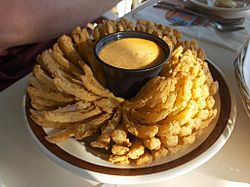Blooming onion facts for kids
 |
|
| Alternative names | Onion bloom, onion blossom, onion flower, onion 'mum |
|---|---|
| Course | Hors d'oeuvre |
| Main ingredients | Onion, batter |
A blooming onion is a fun and unique dish made from a single large onion. It's cut in a special way to look like a flower, then covered in a crispy batter and deep-fried. You'll often find it served as an appetizer (a small dish before the main meal) in some restaurants. It's also known by other names like onion bloom or onion blossom.
How the Blooming Onion Started
People have been making "onion mums" (onions shaped like flowers) since at least 1947, but these weren't fried. The fried version, which is much more popular today, probably began in 1985. This happened at a restaurant called Russell’s Marina Grill in New Orleans. A person named Tim Gannon, who later helped start Outback Steakhouse, worked there at the time.
The blooming onion became very famous in the United States when Outback Steakhouse opened in 1988. Their version was called the "Bloomin' Onion" and was a main item on their menu. It usually comes with a special dipping sauce that each restaurant makes.
In 2016, Outback Steakhouse even offered a special "Loaded Bloomin' Onion" for a short time.
Is the Blooming Onion Healthy?
Because blooming onions are deep-fried and often served with creamy sauces, they can be quite high in calories and fat. This is because of the way they are prepared, using an egg wash and lots of oil for frying.
For example, one blooming onion with its sauce can have a lot of calories and fat. Some studies have shown that these dishes can contain a high amount of fat, including saturated and trans fats. Another similar appetizer, the Awesome Blossom from Chili's, was once noted for its very high calorie and fat content.
However, there are also healthier ways to make or enjoy a blooming onion. Some versions are prepared to have fewer calories and less fat. It's always good to remember that foods like this are best enjoyed as an occasional treat, as part of a balanced diet.

